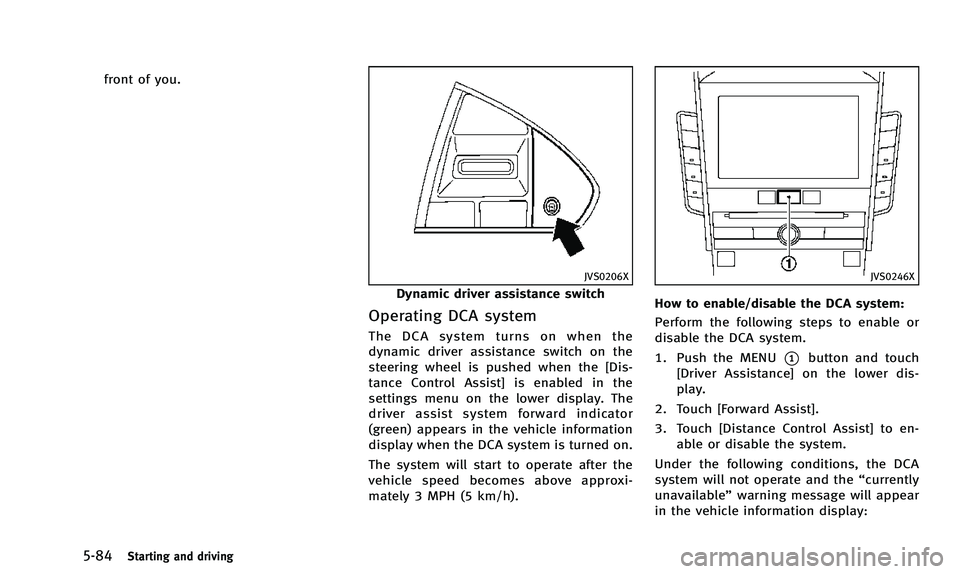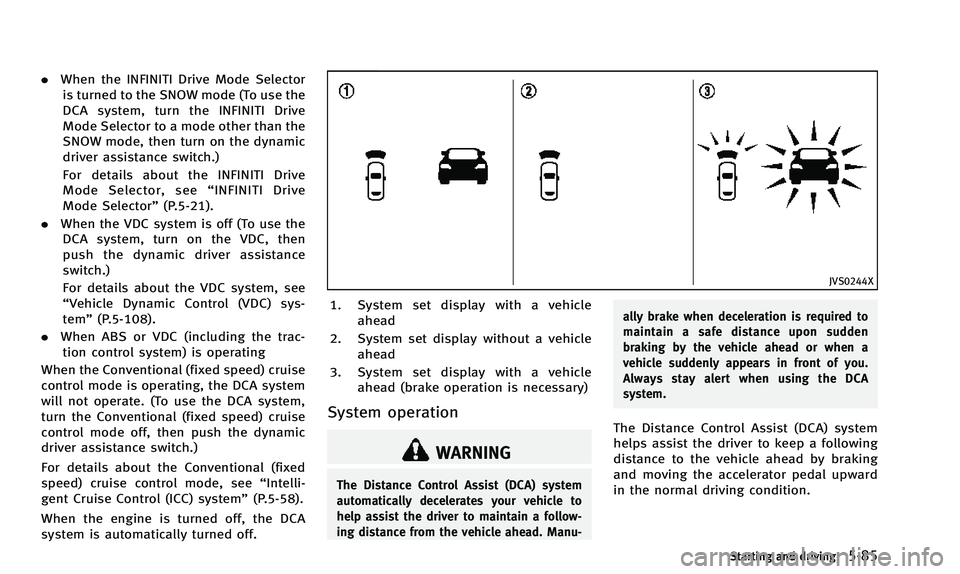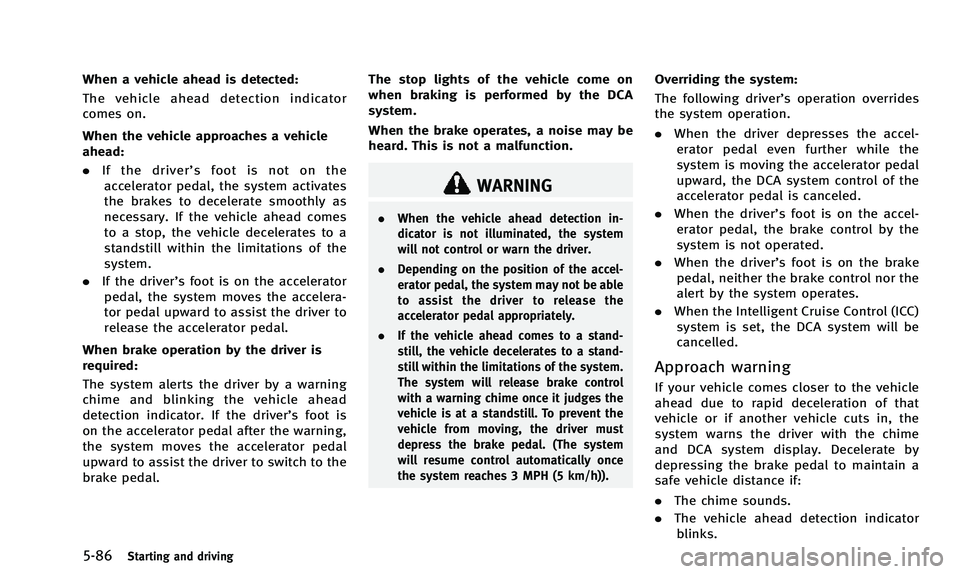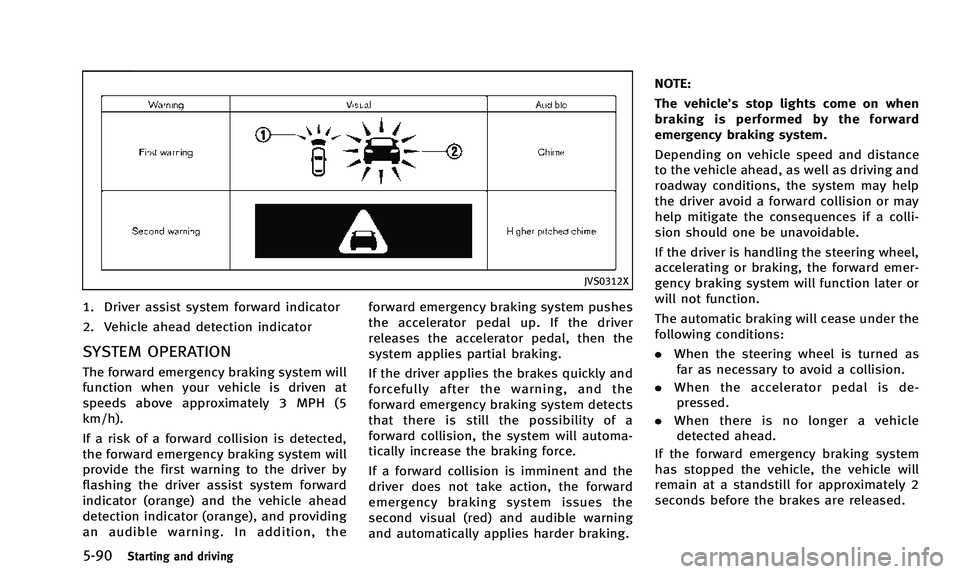warning INFINITI Q50 2014 Owners Manual
[x] Cancel search | Manufacturer: INFINITI, Model Year: 2014, Model line: Q50, Model: INFINITI Q50 2014Pages: 394, PDF Size: 1.99 MB
Page 254 of 394

The Distance Control Assist (DCA) system
brakes and moves the accelerator pedal
upward according to the distance from and
the relative speed of the vehicle ahead to
help assist the driver to maintain a
following distance.
WARNING
.Always drive carefully and attentively
when using the DCA system. Read and
understand the Owner’s Manual thor-
oughly before using the DCA system. To
avoid serious injury or death, do not rely
on the system to prevent accidents or to
control the vehicle’s speed in emergency
situations. Do not use the DCA system
except in appropriate road and traffic
conditions.
. If the vehicle ahead comes to a stop, the
vehicle decelerates to a standstill within
the limitations of the system. The
system will cancel once it judges that
the vehicle has come to a standstill with
a warning chime. To prevent the vehicle
from moving, the driver must depress
the brake pedal.
. The DCA system will not apply brake
control while the driver’s foot is on the accelerator pedal.
JVS0235X
PRECAUTIONS ON DCA SYSTEM
The system is intended to assist the driver
to keep a following distance from the
vehicle ahead traveling in the same lane
and direction.
If the radar sensor
*Adetects a slower
moving vehicle ahead, the system will
reduce the vehicle speed to help assist
the driver to maintain a following distance.
The system automatically controls the
throttle and applies the brakes (up to
approximately 40% of vehicle braking
power) if necessary.
The detection range of the sensor is
Starting and driving5-79
DISTANCE CONTROL ASSIST (DCA) SYSTEM
(if so equipped)
Page 255 of 394

5-80Starting and driving
approximately 650 ft (200 m) ahead.
WARNING
.This system is only an aid to assist the
driver and is not a collision warning or
avoidance device. It is the driver’ s
responsibility to stay alert, drive safely
and be in control of the vehicle at all
times.
. This system will not adapt automatically
to road conditions. Do not use the
system on roads with sharp curves, or
on icy roads, in heavy rain or in fog.
The radar sensor will not detect the
following objects:
.Stationary and slow moving vehicles
. Pedestrians or objects in the roadway
. Oncoming vehicles in the same lane
. Motorcycles traveling offset in the travel
lane
WARNING
. As there is a performance limit to the
distance control function, never rely solely on the DCA system. This system
does not correct careless, inattentive or
absent-minded driving, or overcome
poor visibility in rain, fog, or other bad
weather. Decelerate the vehicle speed by
depressing the brake pedal, depending
on the distance to the vehicle ahead and
the surrounding circumstances in order
to maintain a safe distance between
vehicles.
. The system may not detect the vehicle in
front of you in certain road or weather
conditions. To avoid accidents, never use
the DCA system under the following
conditions:
—On roads with sharp curves
—On slippery road surfaces such as
on ice or snow, etc.
—During bad weather (rain, fog, snow,etc.)
—When rain, snow or dirt adhere tothe system sensor
—On steep downhill roads (frequentbraking may result in overheating
the brakes)
—On repeated uphill and downhillroads .
In some road or traffic conditions, a
vehicle or object can unexpectedly come
into the sensor detection zone and cause
automatic braking. You may need to
control the distance from other vehicles
using the accelerator pedal. Always stay
alert and avoid using the DCA system
when it is not recommended in this
section.
Page 256 of 394

JVS0235X
DCA SYSTEM OPERATION
Always pay attention to the operation of
the vehicle and be ready to manually
decelerate to maintain the proper following
distance. The Distance Control Assist (DCA)
system may not be able to decelerate the
vehicle under some circumstances.
The DCA system uses a sensor
*Alocated
behind the lower grille of the front bumper
to detect vehicles traveling ahead.
The following are some conditions in which
the sensor cannot detect the signals:
. When the snow or road spray from
traveling vehicles reduces the sensor’s visibility
. When excessively heavy baggage is
loaded in the rear seat or the luggage
room of your vehicle
The DCA system is designed to automati-
cally check the sensor’s operation. When
the sensor area of the front bumper is
covered with dirt or is obstructed, the
system will automatically be canceled. If
the sensor area is covered with ice, a
transparent or translucent vinyl bag, etc.,
the DCA system may not detect them. In
these instances, the DCA system may not
be able to decelerate the vehicle properly.
Be sure to check and clean the sensor area
regularly.
The DCA system is designed to help assist
the driver to maintain a following distance
from the vehicle ahead. The system will
decelerate as necessary and if the vehicle
ahead comes to a stop, the vehicle
decelerates to a standstill. However, the
DCA system can only apply up to approxi-
mately 40% of the vehicles total braking
power. If a vehicle moves into the traveling
lane ahead or if a vehicle traveling ahead
rapidly decelerates, the distance between
vehicles may become closer because the
DCA system cannot decelerate the vehicle quickly enough. If this occurs, the DCA
system will sound a warning chime and
blink the system display to notify the driver
to take necessary action.
See
“Approach warning” (P.5-86).
This system only brakes and moves the
accelerator pedal upward to help assist the
driver to maintain a following distance
from the vehicle ahead. Acceleration
should be operated by the driver.
The DCA system does not control vehicle
speed or warn you when you approach
stationary and slow moving vehicles. You
must pay attention to vehicle operation to
maintain proper distance from vehicles
ahead.
Starting and driving5-81
Page 259 of 394

5-84Starting and driving
front of you.
JVS0206X
Dynamic driver assistance switch
Operating DCA system
The DCA system turns on when the
dynamic driver assistance switch on the
steering wheel is pushed when the [Dis-
tance Control Assist] is enabled in the
settings menu on the lower display. The
driver assist system forward indicator
(green) appears in the vehicle information
display when the DCA system is turned on.
The system will start to operate after the
vehicle speed becomes above approxi-
mately 3 MPH (5 km/h).
JVS0246X
How to enable/disable the DCA system:
Perform the following steps to enable or
disable the DCA system.
1. Push the MENU
*1button and touch
[Driver Assistance] on the lower dis-
play.
2. Touch [Forward Assist].
3. Touch [Distance Control Assist] to en- able or disable the system.
Under the following conditions, the DCA
system will not operate and the “currently
unavailable” warning message will appear
in the vehicle information display:
Page 260 of 394

.When the INFINITI Drive Mode Selector
is turned to the SNOW mode (To use the
DCA system, turn the INFINITI Drive
Mode Selector to a mode other than the
SNOW mode, then turn on the dynamic
driver assistance switch.)
For details about the INFINITI Drive
Mode Selector, see “INFINITI Drive
Mode Selector” (P.5-21).
. When the VDC system is off (To use the
DCA system, turn on the VDC, then
push the dynamic driver assistance
switch.)
For details about the VDC system, see
“Vehicle Dynamic Control (VDC) sys-
tem” (P.5-108).
. When ABS or VDC (including the trac-
tion control system) is operating
When the Conventional (fixed speed) cruise
control mode is operating, the DCA system
will not operate. (To use the DCA system,
turn the Conventional (fixed speed) cruise
control mode off, then push the dynamic
driver assistance switch.)
For details about the Conventional (fixed
speed) cruise control mode, see “Intelli-
gent Cruise Control (ICC) system” (P.5-58).
When the engine is turned off, the DCA
system is automatically turned off.
JVS0244X
1. System set display with a vehicle ahead
2. System set display without a vehicle ahead
3. System set display with a vehicle ahead (brake operation is necessary)
System operation
WARNING
The Distance Control Assist (DCA) system
automatically decelerates your vehicle to
help assist the driver to maintain a follow-
ing distance from the vehicle ahead. Manu- ally brake when deceleration is required to
maintain a safe distance upon sudden
braking by the vehicle ahead or when a
vehicle suddenly appears in front of you.
Always stay alert when using the DCA
system.
The Distance Control Assist (DCA) system
helps assist the driver to keep a following
distance to the vehicle ahead by braking
and moving the accelerator pedal upward
in the normal driving condition.
Starting and driving5-85
Page 261 of 394

5-86Starting and driving
When a vehicle ahead is detected:
The vehicle ahead detection indicator
comes on.
When the vehicle approaches a vehicle
ahead:
.If the driver’ s foot is not on the
accelerator pedal, the system activates
the brakes to decelerate smoothly as
necessary. If the vehicle ahead comes
to a stop, the vehicle decelerates to a
standstill within the limitations of the
system.
. If the driver’s foot is on the accelerator
pedal, the system moves the accelera-
tor pedal upward to assist the driver to
release the accelerator pedal.
When brake operation by the driver is
required:
The system alerts the driver by a warning
chime and blinking the vehicle ahead
detection indicator. If the driver’s foot is
on the accelerator pedal after the warning,
the system moves the accelerator pedal
upward to assist the driver to switch to the
brake pedal. The stop lights of the vehicle come on
when braking is performed by the DCA
system.
When the brake operates, a noise may be
heard. This is not a malfunction.
WARNING
.
When the vehicle ahead detection in-
dicator is not illuminated, the system
will not control or warn the driver.
. Depending on the position of the accel-
erator pedal, the system may not be able
to assist the driver to release the
accelerator pedal appropriately.
. If the vehicle ahead comes to a stand-
still, the vehicle decelerates to a stand-
still within the limitations of the system.
The system will release brake control
with a warning chime once it judges the
vehicle is at a standstill. To prevent the
vehicle from moving, the driver must
depress the brake pedal. (The system
will resume control automatically once
the system reaches 3 MPH (5 km/h)).
Overriding the system:
The following driver’s operation overrides
the system operation.
.When the driver depresses the accel-
erator pedal even further while the
system is moving the accelerator pedal
upward, the DCA system control of the
accelerator pedal is canceled.
. When the driver’s foot is on the accel-
erator pedal, the brake control by the
system is not operated.
. When the driver’s foot is on the brake
pedal, neither the brake control nor the
alert by the system operates.
. When the Intelligent Cruise Control (ICC)
system is set, the DCA system will be
cancelled.
Approach warning
If your vehicle comes closer to the vehicle
ahead due to rapid deceleration of that
vehicle or if another vehicle cuts in, the
system warns the driver with the chime
and DCA system display. Decelerate by
depressing the brake pedal to maintain a
safe vehicle distance if:
. The chime sounds.
. The vehicle ahead detection indicator
blinks.
Page 262 of 394

.The driver assist system forward indi-
cator (orange) blinks.
. When the vehicles are traveling at the
same speed and the distance between
vehicles is not changing
. When the vehicle ahead is traveling
faster and the distance between vehi-
cles is increasing
. When a vehicle cuts in near your vehicle
The driver assist system forward indicator
(orange) blinks and the warning chime will
not sound when your vehicle approaches
vehicles that are parked or moving slowly.
SSD0284A
NOTE:
The approach warning chime may sound
and the driver assist system forward
indicator (orange) may blink when the
radar sensor detects objects on the side of
the vehicle
*Aor on the side of the road
*A. This may cause the DCA system to
decelerate or accelerate the vehicle. The
radar sensor may detect these objects
when the vehicle is driven on winding
roads, narrow roads, hilly roads or when
entering or exiting a curve. In these cases
you will have to manually control the
proper distance ahead of your vehicle.
Also, the sensor sensitivity can be affected by vehicle operation (steering maneuver or
driving position in the lane) or traffic or
vehicle condition (for example, if a vehicle
is being driven with some damage).
Automatic cancellation
Condition A:
Under the following conditions, the Dis-
tance Control Assist (DCA) system is
automatically canceled. The chime will
sound and the
“currently unavailable”
warning message will appear in the vehicle
information display. The system will not be
able to be set.
. When the VDC system is turned off
. When the VDC or ABS (including the
traction control system) operates
. When the INFINITI Drive Mode Selector
is turned to the SNOW mode
. When the radar signal is temporarily
interrupted.
Action to take:
When the conditions listed above are no
longer present, turn the DCA system back
on to use the system.
Condition B:
When the radar sensor area of the front
bumper is covered with dirt or is ob-
Starting and driving5-87
Page 263 of 394

5-88Starting and driving
structed, making it impossible to detect a
vehicle ahead, the DCA system is auto-
matically canceled.
The chime will sound, the driver assist
system forward indicator (orange) and the
“front radar obstruction”warning message
will appear in the vehicle information
display.
Action to take:
If the driver assist system forward indicator
(orange) and the warning message appear,
park the vehicle in a safe place, turn the
engine off. When the radar signal is
temporarily interrupted, clean the sensor
area of the front bumper and restart the
engine. If the warning message continues
to be displayed, have the DCA system
checked by an INFINITI retailer.
Condition C:
When the DCA system is not operating
properly, the chime sounds, the driver
assist system forward indicator (orange)
and the system “malfunction” warning
message will appear in the vehicle infor-
mation display. Action to take:
If the driver assist system forward indicator
(orange) and the warning message appear,
park the vehicle in a safe place. Turn the
engine off, restart the engine, and turn on
the DCA system again.
If it is not possible to set the system or the
indicator stays on, it may indicate that the
system is malfunctioning. Although the
vehicle is still driveable under normal
conditions, have the vehicle checked at
an INFINITI retailer.
Sensor maintenance
The sensor for the DCA system is common
with the Intelligent Cruise Control (ICC)
system and is located behind the lower
grille of the front bumper.
For the sensor maintenance, see
“Intelli-
gent Cruise Control (ICC) system” (P.5-58).
FCC Notice:
For USA:
This device complies with Part 15 of the
FCC Rules. Operation is subject to the
following two conditions:
1. This device may not cause harmful
interference, and 2.
This device must accept any interfer-
ence received, including interference
that may cause undesired operation.
FCC Warning
Changes or modification not expressly
approved by the party responsible for
compliance could void the user’s authority
to operate the equipment.
For Canada:
This device complies with Industry Canada
licence-exempt RSS standard(s). Operation
is subject to the following two conditions:
1. This device may not cause interference,
and
2. This device must accept any interfer-
ence, including interference that may
cause undesired operation of the de-
vice.
Page 264 of 394

The forward emergency braking system can
assist the driver when there is a risk of a
forward collision with the vehicle ahead in
the traveling lane.
JVS0235X
The forward emergency braking system
uses a radar sensor
*Alocated behind
the lower grille of the front bumper to
measure the distance to the vehicle ahead
in the traveling lane.
The forward emergency braking system
operates at speeds above approximately
3 MPH (5 km/h). If there is a risk of a
collision, the forward emergency braking
system issues a visual and audible warn-
ing and pushes the accelerator pedal up. If
the driver releases the accelerator pedal,
then the forward emergency braking sys-
tem applies partial braking. If the driver
does not take action, the forward emer- gency braking system issues the second
visual and audible warning, and applies
harder braking.
WARNING
.
The forward emergency braking system
is a supplemental aid to the driver. It is
not a replacement for the driver’s atten-
tion to traffic conditions or responsibility
to drive safely. It cannot prevent acci-
dents due to carelessness or dangerous
driving techniques.
. The forward emergency braking system
does not function in all driving, traffic,
weather and road conditions.
Starting and driving5-89
FORWARD EMERGENCY BRAKING SYSTEM
(if so equipped)
Page 265 of 394

5-90Starting and driving
JVS0312X
1. Driver assist system forward indicator
2. Vehicle ahead detection indicator
SYSTEM OPERATION
The forward emergency braking system will
function when your vehicle is driven at
speeds above approximately 3 MPH (5
km/h).
If a risk of a forward collision is detected,
the forward emergency braking system will
provide the first warning to the driver by
flashing the driver assist system forward
indicator (orange) and the vehicle ahead
detection indicator (orange), and providing
an audible warning. In addition, theforward emergency braking system pushes
the accelerator pedal up. If the driver
releases the accelerator pedal, then the
system applies partial braking.
If the driver applies the brakes quickly and
forcefully after the warning, and the
forward emergency braking system detects
that there is still the possibility of a
forward collision, the system will automa-
tically increase the braking force.
If a forward collision is imminent and the
driver does not take action, the forward
emergency braking system issues the
second visual (red) and audible warning
and automatically applies harder braking.NOTE:
The vehicle’s stop lights come on when
braking is performed by the forward
emergency braking system.
Depending on vehicle speed and distance
to the vehicle ahead, as well as driving and
roadway conditions, the system may help
the driver avoid a forward collision or may
help mitigate the consequences if a colli-
sion should one be unavoidable.
If the driver is handling the steering wheel,
accelerating or braking, the forward emer-
gency braking system will function later or
will not function.
The automatic braking will cease under the
following conditions:
.
When the steering wheel is turned as
far as necessary to avoid a collision.
. When the accelerator pedal is de-
pressed.
. When there is no longer a vehicle
detected ahead.
If the forward emergency braking system
has stopped the vehicle, the vehicle will
remain at a standstill for approximately 2
seconds before the brakes are released.